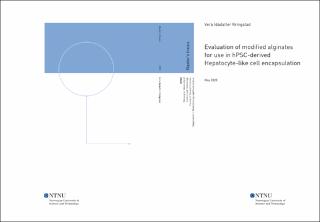| dc.contributor.advisor | Strand, Berit Løkensgard | |
| dc.contributor.advisor | Rashid, Tamir | |
| dc.contributor.author | Kringstad, Vera Idadatter | |
| dc.date.accessioned | 2021-09-25T16:06:21Z | |
| dc.date.available | 2021-09-25T16:06:21Z | |
| dc.date.issued | 2020 | |
| dc.identifier | no.ntnu:inspera:56743445:5705039 | |
| dc.identifier.uri | https://hdl.handle.net/11250/2782535 | |
| dc.description.abstract | Intraperitoneal transplantasjon av alginatinnkapslede humane hepatocytter er en lovende metode for å assistere ved akutt leversvikt, som et alternativ til invasiv levertransplantasjon. Å bruke hepatocyttlignende celler (HLC-er) utviklet fra humane pluripotente stamceller (hPSC) for dette formålet muliggjør en storskala produksjon av celler klare for transplantasjon, uten behov for menneskelige donasjoner. Bruk av alginat for celleinnkapsling har vist mangel på gunstige celle-matriksinteraksjoner, i tillegg til perikapsulær fibrotisk overvekst (PFO) ved intraperitoneal transplantasjon. Denne studien evaluerer bruk av alginater modifisert ved sulfatering og galaktose-poding for en cellespesifikk forbedring i funksjonalitet og levedyktighet av innkapslede HLCer, i tillegg til antiinflammatoriske effekter ved xenotransplantasjon til mus.
Alginatkuler ble laget av både 20% og 40% modifisert alginat, der sistnevnte ble konkludert til å være mest gunstig på grunn av en høyere permeabilitet for partikler på størrelse med viktige hepatiske produkter, og at viskositeten er lavere og dermed forårsaker mindre komplikasjoner i innkapslingsprosessen. Galaktose-alginat viste en gjennomgående negativ effekt på funksjonaliteten til innkapslede celler, mens sulfert alginat ga økt produksjon av hepatiske produkter sammenlignet med celler i umodifisert alginat.
Sulfert alginat hadde redusert immunrespons mot de innkapslede cellene, da PFO-nivået rundt kulene laget av dette alginatet var betydelig lavere enn kulene av umodifisert alginat. Imidlertid var kuler av sulfatert alginat mer utsatt for svelling sammenlignet med umodifisert alginat, noe som kan forklares av den reduserte gelstabiliteten som skyldes tap av koblingssoner i det sulfaterte alginatet. De innkapslede cellene viste økt hepatocytt-funksjonalitet etter transplantasjon, men cellene i sulfatert alginat var mindre funksjonelle enn de i umodifisert alginat.
Observasjoner fra denne studien kan brukes til videre forskning på optimalisering av 3D-kulturer av HLC-er og for alginatinnkapsling av andre celletyper for terapeutiske anvendelser. | |
| dc.description.abstract | Intraperitoneal transplantation of alginate encapsulated human hepatocytes is a promising approach in assisting acute liver failure, as an alternative to invasive liver transplantation. Using hepatocyte-like cells (HLCs) derived from human pluripotent stem cells (hPSCs) for this purpose enables for a large scale production of cells ready for transplantation, without the need for human donations. Use of native alginate for cell encapsulation has shown a lack of favourable cell-matrix interactions, in addition to pericapsular fibrotic overgrowth (PFO) upon intraperitoneal transplantation. This study evaluates the use of alginates modified by sulfation and galactose-grafting for a cell-specific enhancement in functionality and viability of encapsulated hPSC-derived HLCs, together with anti-inflammatory effects during xenotransplantation into mice.
Alginate beads were made of both 20% and 40% modified alginate, where the latter was decided to be more favourable due to a higher permeability for particles with the size of important hepatic products, and to the viscosity being lower and thus causing less complications in the encapsulation process. Galactose-grafted alginate showed an overall negative effect on the functionality of encapsulated cells, while sulfated alginate gave an enhanced production of hepatic products compared to the native alginate.
Sulfated alginate was successfully shown to have reduced the foreign body response towards the encapsulated cells, as the levels of PFO on the beads made from this alginate was significantly lower than the beads made from native alginate. However, beads of sulfated alginate were more prone to swelling compared to the native alginate, which could be explained by a loss of gel stability as a result of the decreased number of junction zones in the sulfated alginate. The encapsulated cells showed an enhanced hepatic functionality after being retrieved from transplantation, however the cells in sulfated alginate beads was less functional than those in native alginate.
The observations reported from this study can be used for further research on optimising 3D cultures of HLCs and on alginate encapsulation of other cell types for therapeutic applications. | |
| dc.language | | |
| dc.publisher | NTNU | |
| dc.title | Evaluation of modified alginates for encapsulation of hPSC-derived Hepatocyte-like cells | |
| dc.type | Master thesis | |
